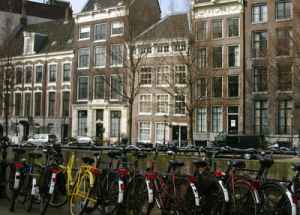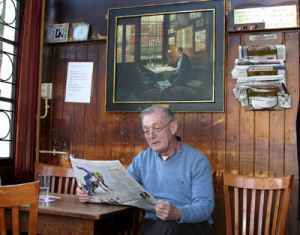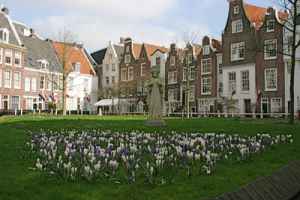- MENU
- HOME
- SEARCH
- WORLD
- MAIN
- AFRICA
- ASIA
- BALKANS
- EUROPE
- LATIN AMERICA
- MIDDLE EAST
- United Kingdom
- United States
- Argentina
- Australia
- Austria
- Benelux
- Brazil
- Canada
- China
- France
- Germany
- Greece
- Hungary
- India
- Indonesia
- Ireland
- Israel
- Italy
- Japan
- Korea
- Mexico
- New Zealand
- Pakistan
- Philippines
- Poland
- Russia
- South Africa
- Spain
- Taiwan
- Turkey
- USA
- BUSINESS
- WEALTH
- STOCKS
- TECH
- HEALTH
- LIFESTYLE
- ENTERTAINMENT
- SPORTS
- RSS
- iHaveNet.com: Travel
Travel to Holland where Old Amsterdam is Always New
By Margaret M. Johnson

More than 600,000 bikes in Amsterdam can usually be found locked to the hundreds of bridges
that span the city's picturesque canals
New York and the Netherlands are in the mood to celebrate this summer, as 2009 marks the 400th anniversary of the arrival of the Dutch ship the "Half Moon" to the shores of "Manna-Hatta," now known as Manhattan.
To partake of some of the U.S. festivities -- lectures, theater, and exhibitions -- visit New York (www.ny400.org).
But as a New Yorker myself, I decided instead to head straight to the source in Holland and spent five glorious days exploring Old Amsterdam, a place that boasts the largest historical city center in Europe.
With close to 7,000 protected monuments -- including houses and buildings dating from the 15th to the early 20th century -- Amsterdam is one of the most popular European cities for international tourists.
Many of the most stunning monuments are found along its ring of crescent-shaped canals, arguably the city's most unique feature, where wealthy seventeenth century merchants built elegant homes and sturdy warehouses during Holland's Golden Age.
Within this network of canals, 90 islands were eventually created and interconnected by 1,280 bridges.
Touring this picturesque spider web of waterways by foot, boat, or bike (most locals use bikes to get around, accounting for the 600,000 of them you see everywhere) is enough to keep anyone busy for any length of stay.
A good plan for orientation to the city, and to see it from an architectural perspective, is to tour the three grand canals -- the Herengracht, Keizersgracht, and Prinsengracht.
Start with the Herengracht at the section of waterway running from Leidsestraat to Vijzelstraat. Known as the "Golden Bend," this is the area where the most beautifully built and decorated of all canal houses are located. Designed by some of the best architects of the period, many are twice the width of an average canal house (taxes were assessed by the width of a home, so most canal side houses were long and narrow) and decorated with elaborate cornices and gables.
A lovely example is the house on the corner of Leidsegracht, which features a Dutch classicist clock gable.
The house is named after the plaque featuring four knights on horseback (Vier Heemskinderen). Several of the other houses sport family coats of arms.

Papeneiland Pub, No. 2 Prinsengracht
Some of the homes on the Prinsengracht are among the city's oldest, with the Papeneiland Pub (No. 2) dating from the 17th century.
Holland's first professional school for nurses, the Prinsengracht Hospital, is also located along this canal, as is the Wallon Orphanage on the corner of Vijzelgracht, Anne Frank's House and Museum (No. 263), and Westerkerk, the church with the tallest tower in the city and the site of Rembrandt's unmarked grave (No. 281).
Some of the city's prettiest houseboats are moored on the Prinsengracht, too, although if you want to see the "Poezenboot," a houseboat especially designed to accommodate stray cats, you'll have to make your way to the western end of the Singel canal.
At No.123 Keizersgracht is the "House with the Heads," where legend has it that the maid caught six burglars red-handed and beheaded them with an axe. The house at No. 546 boasts one of Amsterdam's most beautiful clock gables, and No. 324, the Felix Meritis Building, showcases one of the city's most beautiful neo-classical facades.
Architecture aside, for one of the most beautiful canal spectacles, a visit to the "Bridge of 15 Bridges" is a must.
Here, at the bridge crossing of the Reguliersgracht with the Herengracht, on the odd-numbered side, you can view 14 bridges crisscrossing the canals. You'll be standing on the 15th! At night, when the bridges are lighted, the view from sightseeing cruise boats is not-to-be-missed.
With close to 40 museums citywide, a plan is definitely in order if you want to do any serious viewing
In addition to the Rijksmuseum, both the Van Gogh Museum (www.vangoghmuseum.nl), which showcases more than 200 paintings and 400 of his drawings, and the Stedelijk Museum of Modern Art (www.stedelijk.nl) are only a few minutes' walk away.
But the biggest news on the art scene is the June opening of Hermitage Amsterdam (www.hermitage.nl), housed in the Amstelhof, the largest 17th-century building in the city.
The opening exhibition, "Russian Court Life," features Russian, Western European, and exotic objects from the vast collection of the Hermitage in St. Petersburg. The exhibition will run until the end of January 2010.
Several places of interest are free of charge

The Begijnof
The Schuttersgallerij, or Civic Guards Gallery, where 15 enormous paintings hang on display near the entrance to Amsterdam Historical Museum (www.ahm.nl)
The Begijnof, a quaint village square in the heart of the city with a small medieval church (www.begijnhofamsterdam.nl)
Zuiderkerk, where you can see a detailed picture of the city planning and housing in Amsterdam through the centuries (www.zuiderkerk.amsterdam.nl); and
The floating market on the Singel, one of the most colorful and sweet-smelling attractions in the city.
Touring the city's famous "Red Light District" is also free of charge -- but only for window-shopping!
If you're in the mood to celebrate the 400-year old bond between the United States and the Netherlands, I'd strongly suggest you do it on Dutch turf.
© Margaret M. Johnson Distributed by Tribune Media Services, Inc.
AUTOS | HOBBIES | EDUCATION | FAMILY | FASHION | FOOD & RECIPES | HOME DECOR | RELATIONSHIPS | PARENTING | PETS | TRAVEL | WOMEN
Travel | Holland - Old Amsterdam is Always New - Margaret M. Johnson World's Fare